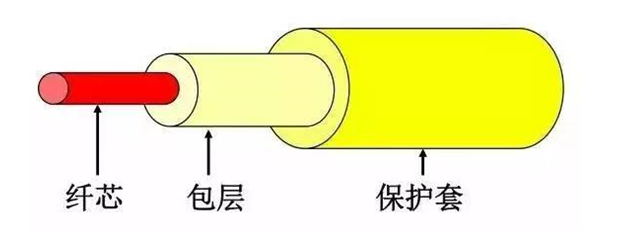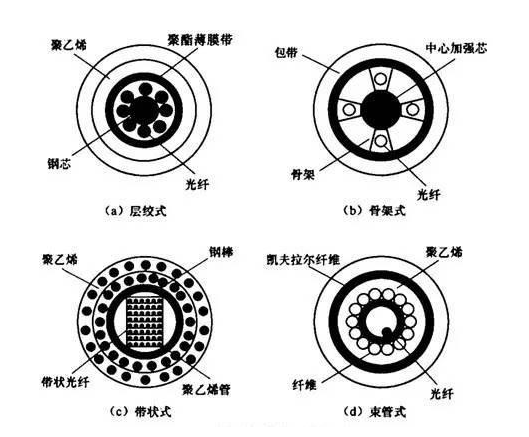Fiber Optic Patch Cord Optical Fiber Transmission Knowledge SharingAs a light transmission tool,optical fiber has been widely used in engineering projects because of its faster transmission rate,more stable signal,higher safety factor,and more environmental protection.The optical fiber cable is a communication cable assembly that uses one or more optical fibers placed in a sheath as a transmission medium and can be used individually or in groups.How much do you know about[fiber knowledge]about optical fiber and optical cable in daily projects?
1.Briefly describe the composition of optical fiber?
Answer:Optical fiber consists of two basic parts:core,cladding and coating made of transparent optical materials.

2.What are the basic parameters describing the transmission characteristics of optical fiber lines?
Answer:Including loss,dispersion,bandwidth,cutoff wavelength,mode field diameter,etc.
3.What are the reasons for fiber attenuation?
Answer:The attenuation of an optical fiber refers to the reduction of optical power between two cross-sections of an optical fiber,which is related to the wavelength.The main causes of attenuation are scattering,absorption,and optical loss due to connectors and splices.
4.How is the fiber attenuation coefficient defined?
Answer:It is defined by the attenuation(dB/km)per unit length of a uniform optical fiber in a steady state.
5.What is insertion loss?
Answer:It refers to the attenuation caused by inserting optical components(such as inserting connectors or couplers)in optical transmission lines.
6.What is the bandwidth of optical fiber related to?
Answer:The bandwidth of an optical fiber refers to the modulation frequency when the amplitude of the optical power is 50%or 3dB lower than the amplitude of the zero frequency in the transfer function of the optical fiber.The bandwidth of an optical fiber is approximately inversely proportional to its length,and the product of the bandwidth length is a constant.
7.How many types of dispersion are there in optical fiber?What are they related to?
Answer:Optical fiber dispersion refers to the broadening of the group delay in an optical fiber,including mode dispersion,material dispersion,and structural dispersion.It depends on the characteristics of both the light source and the optical fiber.
8.How to describe the dispersion characteristics of the signal propagating in the optical fiber?
Answer:It can be described by three physical quantities:pulse broadening,optical fiber bandwidth,and optical fiber dispersion coefficient.
9.What is the cut-off wavelength?
Answer:It refers to the shortest wavelength that can only transmit the fundamental mode in the fiber.For single-mode fiber,its cutoff wavelength must be shorter than the wavelength of the transmitted light.
10.What impact will the dispersion of optical fiber have on the performance of optical fiber communication systems?
Answer:The dispersion of the optical fiber will cause the light pulse to broaden during transmission in the optical fiber.It affects the size of the bit error rate,the length of the transmission distance,and the size of the system rate.

The phenomenon of light pulse broadening caused by different group velocities of different wavelengths in the optical fiber spectral composition.
11.What are the most common optical cable structures?
Answer:There are two types:layer twisted and skeleton.

12.What is the main composition of the optical cable?
Answer:It consists of fiber core,fiber optic ointment,sheath material,PBT(polybutylene terephthalate)and other materials.
13.What is the armor of the optical cable?
Answer:It refers to the protective element(usually steel wire or steel belt)used in special-purpose optical cables(such as submarine optical cables,etc.).The armor is attached to the inner sheath of the cable.
14.What material is used for the cable sheath?
Answer:The cable sheath or sheath is usually made of polyethylene(PE)and polyvinyl chloride(PVC)materials,and its function is to protect the cable core from external influences.
15.List special optical cables used in power systems.
Answer:There are mainly three kinds of special optical cables:ground wire composite optical cable(OPGW),the optical fiber is placed in the power line of the steel-clad aluminum strand structure.The application of OPGW optical cable plays the dual functions of ground wire and communication,effectively improving the utilization rate of power poles and towers.Wrapped fiber optic cable(GWWOP),where the power transmission line already exists,this kind of fiber optic cable is wound or suspended on the ground wire.The self-supporting optical cable(ADSS)has a strong tensile capacity and can be directly hung between two power poles and towers,and its maximum span can reach 1000m.
16.How many types of OPGW optical cable application structures are there?
Answer:There are mainly:1)the structure of plastic tube layer twisted+aluminum tube;2)the structure of central plastic tube+aluminum tube;3)the structure of aluminum skeleton;4)the structure of spiral aluminum tube;5)the structure of single-layer stainless steel tube(center 6)Composite stainless steel tube structure(central stainless steel tube structure,stainless steel tube layer stranded structure).
17.What is the main composition of the stranded wire outside the core of the OPGW optical cable?
Answer:It consists of AA wire(aluminum alloy wire)and AS wire(aluminum-clad steel wire).
18.To choose the OPGW optical cable model,what are the technical conditions that should be met?
Answer:1)Nominal tensile strength(RTS)(kN)of OPGW optical cable;2)Number of fiber cores(SM)of OPGW optical cable;3)Short circuit current(kA);4)Short circuit time(s);5)Temperature Range(°C).
19.How is the bending degree of the optical cable limited?
Answer:The bending radius of the optical cable should not be less than 20 times the outer diameter of the optical cable,and not less than 30 times the outer diameter of the optical cable during construction(non-stationary state).
Paying attention to Fiber Optic Patch CordYu can bring you more knowledge about optical fiber and optical cable.



